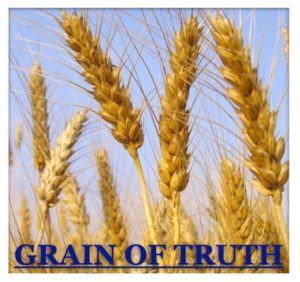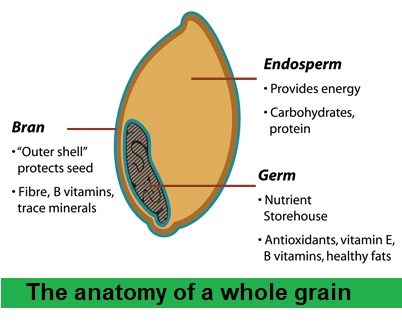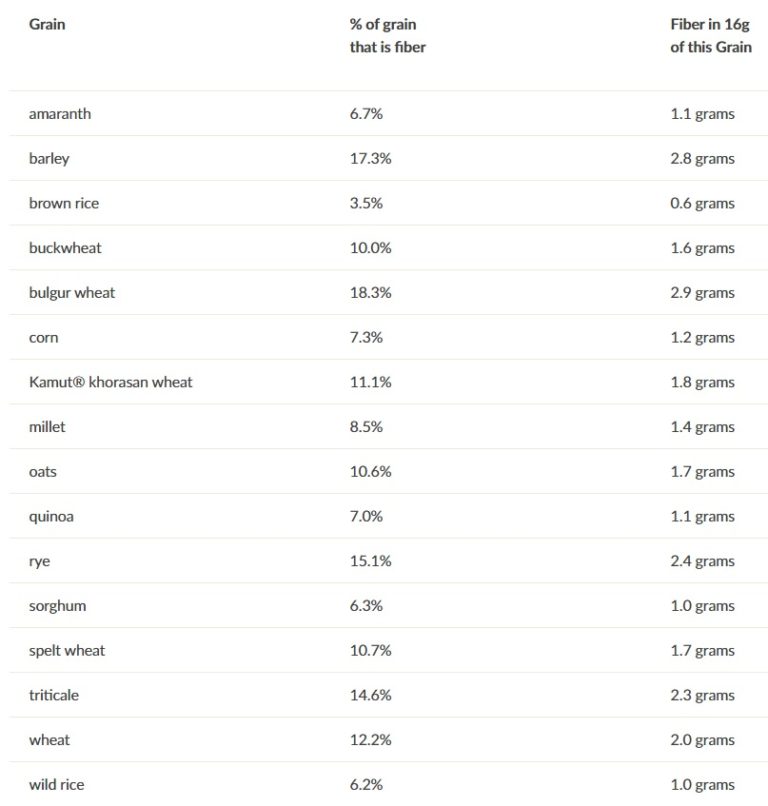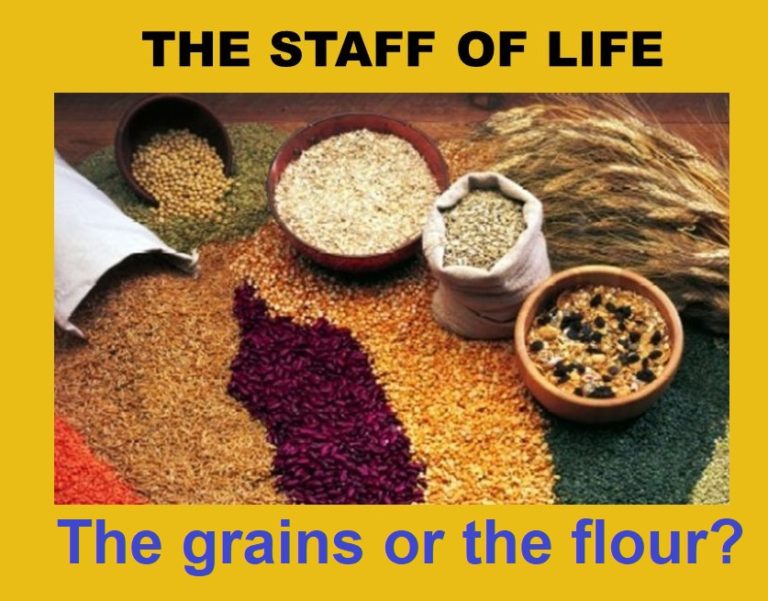
Okay, if you made bread from whole grains rather than floured grains, it would be a bit of a mess! However, there are compelling reasons why eating whole grains (wheat, barley, buckwheat, etc) provides far more health benefits than eating even the healthiest goods made with flour. And we’re not talking here about wholegrain, 1 as opposed to processed or refined grains – we’re talking about the whole grain – the complete edible part of the grain which has not been milled or ground down to millions of small particles, as happens when making any flour – be it wholegrain/wholemeal or highly refined (white flour).
The central message of this article concerns the different effects that grains and flours have inside your guts. First, though, a bit of background.
Blog Contents
Anatomy of a grain

The above diagram shows the three parts of a grain:
- bran – the outer shell which protects the grain, containing most of the fibre
- endosperm – the major internal part providing food (energy) to the germ
- germ – the smaller internal part which provides the seed for future generations
What happens during flour milling?
When whole grains are milled to make refined flour, the bran and germ are removed, leaving only the endosperm. When whole grains are milled to make wholegrain flour, all three parts are ground down and made into a flour. Most people would have become aware that refined (white) flour is not as good for you as wholegrain flour, since the latter still provides some of the benefits of fibre, including:
- helping to control blood glucose levels – thereby reducing sugar/insulin spikes
- helping to maintain/ improve insulin resistance – a central feature of type 2 diabetes
- increasing stool bulk – easing passage through the intestines and helping to prevent constipation
- keeping you feeling full for longer
- reducing blood cholesterol
Which grain has most fibre?
Just out of interest, the following is a list 2 of various grains, showing the average fibre content:

Take it out to put it back in
Vitamin E (a powerful antioxidant) 3 , B vitamins (essential for energy production, amongst other things) and trace minerals (including magnesium, selenium and zinc) 4 are partly destroyed by the time the final flour-based products have been baked. This is especially the case with ‘white’ flour (white because the darker-coloured fibre has been removed).
As an example, during milling, wheat loses 50% of its original phosphorus and calcium, 66% of iron, 50-70% of thiamine (vitamin B1)), 80% of niacin (vitamin B3), and 33% of tocopherol (vitamin E) 5 .
These and other nutrients – usually synthetic versions 6 – can then be added back into the final flour, thereby ‘enriching’ or ‘fortifying’ it. All well and good, but there’s plenty of strong evidence 7 suggesting, not only that the original nutrients combined within the actual plant (in this case, grains) are more effective than separately added vitamins and minerals, but studies 8 also show that some added ‘nutrients’ can be seriously harmful to health.
What else does commercially prepared flour contain?
I’m not even bothering to consider other flour products apart from bread (such as pies, pasties, cakes etc). The latter are generally so full of junk (whether animal- or plant-based) that, even if the pastry were of the highest possible quality, the product usually contains other ingredients than few WFPB nutritionists would recommend. However, if you’re determined to eat bread, the range of commercially produced offerings range from the reasonably okay to the downright awful.
Things to look out for, and, preferably, avoid:
- salt 9
- “Dozens of similar studies demonstrate that if you reduce your salt intake, you may reduce your blood pressure. And the greater the reduction, the greater the benefit may be. But if you don’t cut down, chronic high salt intake can lead to a gradual increase in blood pressure throughout life.“
- sugar
- some of my recipes contain a small amount, but commercial breads usually contain far too much
- vegetable oils 10 11
- “Research confirms that ingestion of oil, no matter which type of oil or whether it was fresh or deep fried, showed a significant and constant decrease in arterial function.” 12
- trans fats 13 14
- trans fats (“partially hydrogenated” oils) are linked to serious health risks
- potassium bromate (oxidising agent)
- azodicarbonamide (dough conditioner/bleacher)
- monoglycerides & diglycerides (emulsifiers E471)
- butylated hydrocyanisole (BHA)
- caramel colouring
- high fructose corn syrup (HFCS)
- undeclared GMO soy oil 23
- “The bottom line is that there is no direct human data suggesting harm from eating GMOs, though in fairness such studies haven’t been done, which is exactly the point, critics counter. That’s why we need mandatory labelling on GMO products so that public health researchers can track whether GMOs are having any adverse effects.”
And this isn’t a definitive list..
There have to be some benefits of refined flour…
Whilst there are no obvious health benefits to stripping whole grains of bran and germ, it does provide a longer shelf life. It also means the products ‘hit the sweet spot’ more quickly and can be a lot more addictive. The producers and retailers benefit when the consumer can’t resist another slice (or two) of the easily chewed and digested pap. So what if the blood glucose hits the roof? It’s well-known that when blood sugar levels rise quickly, they’ll drop just as quickly and result in rebound hunger. Your hunger won’t leave you alone.
Whole grains and the microbiome
This is the take-home bit of the blog. When you eat a milled grain, which consists of millions of tiny particles, most of it gets absorbed and digested well before it reaches your large intestine (the colon). However, when you eat a whole grain, chewing and digestion in the stomach and small intestine tend to leave much larger ‘chunks’ of grain that reach the colon.
So what?
In the colon, trillions of gut bacteria (the microbiota or gut flora) are waiting for these chunks of grain (prebiotics) so that they can further digest them and, thereby, release bi-products back into our bloodstream – bi-products which are of significant importance to our overall health – from reinforcing our immune system, protecting the endothelial cells of our blood vessels, to protecting us from mental depression.
The fascinating subject of gut bacteria has been covered in great detail in several previous blogs 24 25 26 27 . The chunks of whole grain act as prebiotics for our gut bacteria.
Final thoughts
So, if you want to provide valuable fuel for those little guys down there in your colon, stick to whole grains (boiled first, of course), and leave the bread, pasties, cakes, biscuits and other flour products on the shelf for the most part.
If you can’t live without bread, try to make it yourself. I’ve provided some really simple recipes 28 29 30 for a variety of bread types, each of which avoids the use of salt and oil. And if you can’t live without a bit of salt in your bread, then still best to make it yourself rather than buy commercially prepared bread.

References
- Wholegrain, wholewheat and wholemeal are all terms which tend to be used interchangeably to refer to the same thing. [↩]
- Oldways Whole Grains Council: FIBER IN WHOLE GRAINS [↩]
- The cereal grains: focus on vitamin E [2001]. Zielinski, H. Ciska, E. Kozlowska, H. [↩]
- J Am Diet Assoc. 2001 Jul;101(7):780-5. The role of whole grains in disease prevention. Slavin JL, Jacobs D, Marquart L, Wiemer K. [↩]
- White Enriched Bread vs. Whole Wheat Bread – Purdue e-Pubs. [↩]
- Med Hypotheses. 2000 Dec;55(6):461-9. Natural vitamins may be superior to synthetic ones. Thiel RJ. [↩]
- Vitamin C Supplements vs An Apple [↩]
- How To Analyse the Health Claims Made for Dietary Supplements [↩]
- nutritionfacts.org. Topics: salt. [↩]
- CNS. Plant Oils Are Not a Healthy Alternative to Saturated Fat by T. Colin Campbell, PhD. July 21, 2016. [↩]
- McDougall Newsletter August 2007. When Friends Ask: Why Do You Avoid Adding Vegetable Oils? [↩]
- nutritionfacts.org. Topics: vegetable oil. [↩]
- Vandana Dhaka, Neelam Gulia, Kulveer Singh Ahlawat, and Bhupender Singh Khatkarcorresponding. J Food Sci Technol. 2011 Oct; 48(5): 534–541. Published online 2011 Jan 28. doi: 10.1007/s13197-010-0225-8. Trans fats—sources, health risks and alternative approach – A review. [↩]
- Trattner S, Becker W, Wretling S, Öhrvik V, Mattisson I. Food Chem. 2015 May 15;175:423-30. doi: 10.1016/j.foodchem.2014.11.145. Epub 2014 Dec 3. Fatty acid composition of Swedish bakery products, with emphasis on trans-fatty acids. [↩]
- Otterweck AA, Verhagen H, Goldbohm RA, Kleinjans J, van den Brandt PA. Food Chem Toxicol. 2000 Jul;38(7):599-605. Intake of butylated hydroxyanisole and butylated hydroxytoluene and stomach cancer risk: results from analyses in the Netherlands Cohort Study. [↩]
- https://ntp.niehs.nih.gov/ntp/roc/content/profiles/butylatedhydroxyanisole.pdf. [↩]
- https://www.fda.gov/downloads/Food/GuidanceRegulation/FSMA/UCM517402.pdf. [↩]
- Food caramels: a review – NCBI – NIH. [↩]
- BMC Nephrol. 2018 Nov 8;19(1):315. doi: 10.1186/s12882-018-1105-0. Fructose increases risk for kidney stones: potential role in metabolic syndrome and heat stress. Johnson RJ et al. [↩]
- nutritionfacts.org. Topics: High Fructose Corn Syrup. [↩]
- Nutrients. 2017 Jan; 9(1): 11. High Dietary Fructose Intake on Cardiovascular Disease Related Parameters in Growing Rats. SooYeon Yoo, er al. [↩]
- Glob Public Health. 2013;8(1):55-64. High fructose corn syrup and diabetes prevalence: a global perspective. Goran MI, Ulijaszek SJ, Ventura EE. [↩]
- GMO Soy & Breast Cancer. Michael Greger M.D. FACLM November 17th, 2014 Volume 21. [↩]
- Fibromyalgia, Probiotics & Gut Microbiota [↩]
- Two Types of Gut Bacteria: Plant Eaters’ & Meat Eaters’ [↩]
- Obstructive Sleep Apnea (OSA) & Gut Microbiota [↩]
- Gut Microbiota & Depression [↩]
- You Will Not Find A Simpler Bread Recipe [↩]
- Yuri’s Wholesome Bread Recipe [↩]
- Breads & Baking [↩]